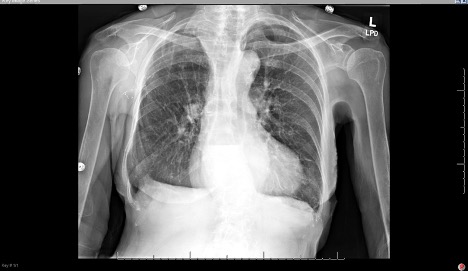Issue 5:3
Hemoptysis Due to Diffuse Alveolar Hemorrhage
DOI: https://doi.org/10.21980/J8ZP86By the end of this simulation session, learners will be able to: (1) recognize worsening respiratory status of a patient with hemoptysis and intervene appropriately, (2) manage a patient with severe hemoptysis and perform appropriate ventilator management, (3) manage sinus tachycardia with QT prolongation on the ECG caused by cocaine and hypomagnesemia, (4) address various etiologies of hemoptysis, (5) discuss the causes of massive hemoptysis and management options, and (6) review ventilation strategies in an intubated hypoxic patient.
Improving Emergency Department Airway Preparedness in the Era of COVID-19: An Interprofessional, In Situ Simulation
DOI: https://doi.org/10.21980/J8V06MAt the conclusion of the simulation session, learners will be able to: 1) Understand the need to notify team members of a planned COVID intubation including: physician, respiratory therapist, pharmacist, nurse(s), and ED technician. 2) Distinguish between in-room and out-of-room personnel during high-risk aerosolizing procedures. 3) Distinguish between in-room and out-of-room equipment during high-risk aerosolizing procedures to minimize contamination. 4) Appropriately select oxygenation therapies and avoid high-risk aerosolizing procedures. 5) Manage high risk scenarios such as hypotension or failed intubation and be prepared to give push-dose vasoactive medications or place a rescue device such as an I-gel®.
Eclampsia
DOI: https://doi.org/10.21980/J8M93DAt the end of this oral boards session, examinees will: 1) Demonstrate ability to obtain a complete medical history including a detailed obstetric history. 2) Demonstrate the ability to perform a detailed physical examination in a postpartum female patient who presents with a seizure. 3) Investigate the broad differential diagnoses which include electrolyte imbalances, brain tumor, meningitis or encephalitis, hemolysis, elevated liver enzymes, low platelets (HELLP) syndrome and eclampsia. 4) List the appropriate laboratory and imaging studies to differentiate eclampsia from other diagnoses (complete blood count, comprehensive metabolic panel, magnesium level, pregnancy testing, urinalysis, and computed tomography [CT] scan of the head). 5) Identify a postpartum eclampsia patient and manage appropriately (administer IV magnesium therapy, administer IV antihypertensive therapy, emergent consultation with an obstetrician). 6) Provide appropriate disposition to the intensive care unit after consulting with an obstetrician.
Low Fidelity Trainer for Fiberoptic Scope Use in the Emergency Department
DOI: https://doi.org/10.21980/J8764BBy the end of this training session, learners will be able to 1) list indications, contraindication, and complications in performing fiberoptic intubations, 2) know how to use and maneuver a fiberoptic scope, and 3) be able to successfully intubate the trainer model.
Periodic Refresher Emails for Emergency Department Mass Casualty Incident Plans
DOI: https://doi.org/10.21980/J8C05WThis curriculum is intended to maintain a knowledge base of MCI processes to mitigate degradation of necessary knowledge between hands-on MCI training.
A Model Curriculum for a Helicopter Emergency Medicine Services (HEMS) Rotation for Resident Physicians
DOI: https://doi.org/10.21980/J8GP97The primary objective of this course is to present a standardized curriculum which allows learners to gain understanding of HEMS systems and retrieval medicine while practicing safety in the aviation environment.
Pediatric Seizure Team-Based Learning
DOI: https://doi.org/10.21980/J8MD22 By the end of this TBL session, learners should be able to: 1) Define features of simple versus complex febrile seizure, 2) Discuss which patients with seizure may require further diagnostic workup, 3) Summarize a discharge discussion for a patient with simple febrile seizures
4) Identify a differential diagnosis for pediatric patients presenting with seizure, 5) Define features of status epilepticus, 6) Review an algorithm for the pharmacologic management of status epilepticus, 7) Indicate medication dosing and routes of various benzodiazepine treatments, 8) Obtain a thorough history in an infant patient with seizures to recognize hyponatremia due to improperly prepared formula, 9) Choose the appropriate treatment for a patient with a hyponatremic seizure, 10) Describe the anatomy of a ventriculoperitoneal (VP) shunt, 11) Relate a differential diagnosis of VP shunt malfunction, 12) Compare and contrast the neuroimaging options for a patient with a VP shunt
Build Your Own Eye: A Method for Teaching Ocular Anatomy and Pathophysiology
DOI: https://doi.org/10.21980/J8GS8WBy the end of this session the participant will be able to: 1) Describe basic anatomy of the eye, 2) Build a basic model of the eye, 3) Identify which diseases are associated with which parts of the eye, 4) Identify the pathophysiology behind diseases of the eye, 5) Name correct treatment for each disease.
Severe Hyperkalemia
DOI: https://doi.org/10.21980/J8KH1DThe initial ECG obtained upon arrival shows what is commonly referred to as a sine wave pattern. This patient does have a biventricular pacemaker which would ordinarily create a wide QRS complex mimicking an intraventricular conduction delay. However, the QRS complex here is exceptionally wide, in excess of 400 milliseconds (normal: less than 120 milliseconds). As the QRS widens, alongside other deflections present on the ECG, it morphologically mimics a mathematical sine wave.
Is an X-ray a Useful Test for Esophageal Food Boluses? A Case Report
DOI: https://doi.org/10.21980/J8Q639The plain film radiograph of the chest demonstrated a fluid level (yellow arrow) in the distal esophagus with dilation of the esophagus proximal to that point (blue line). Neither of these findings were present on the previous visit.
1›
Page 1 of 2


